Business Skills for Startups
VerifiedAdded on 2020/06/05
|12
|4155
|161
AI Summary
This assignment examines the crucial business skills required for success in the dynamic world of tech startups. It delves into topics such as effective negotiation strategies, clear communication techniques, and robust project management methodologies. The focus is on equipping aspiring entrepreneurs with the practical knowledge and tools necessary to navigate the challenges and opportunities inherent in launching and growing a successful startup.
Contribute Materials
Your contribution can guide someone’s learning journey. Share your
documents today.
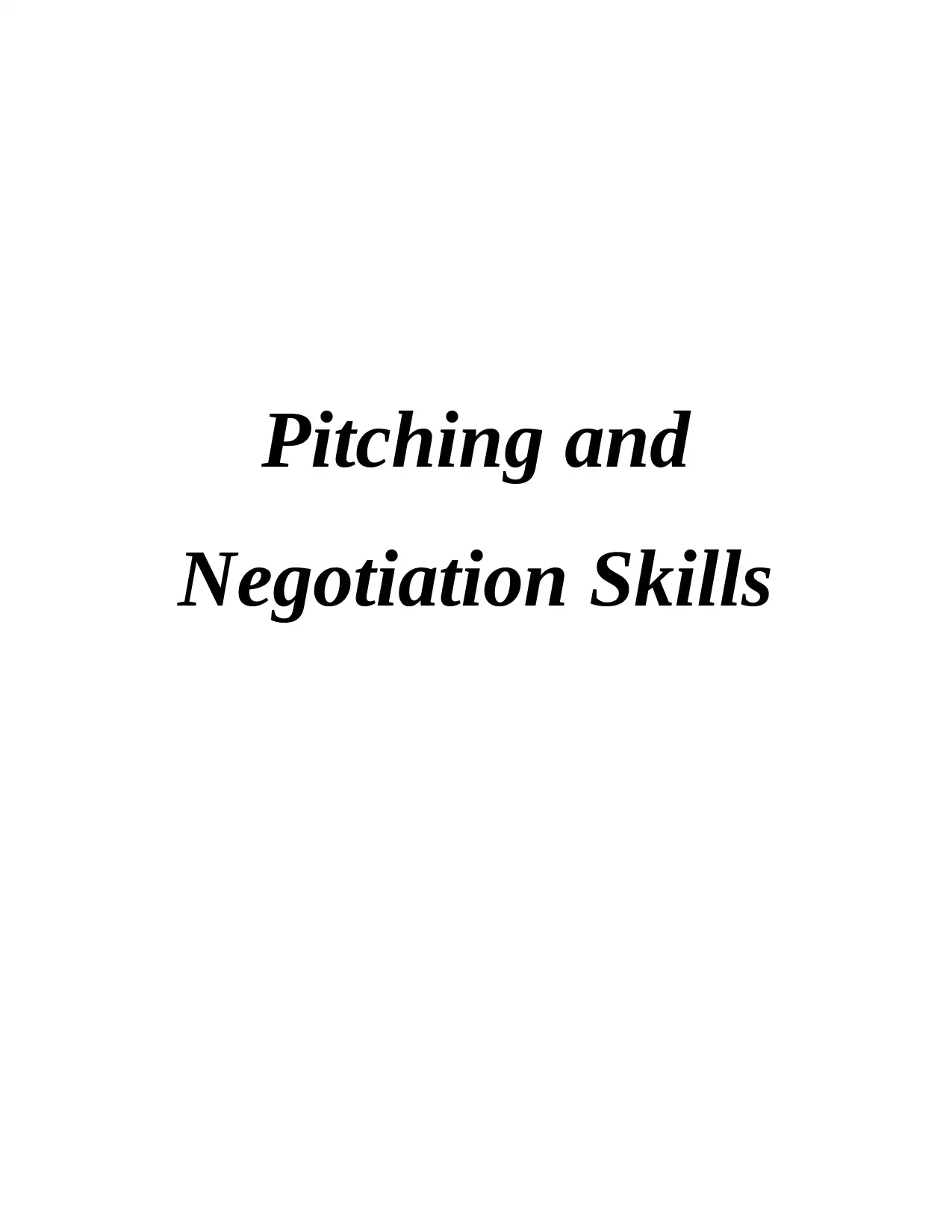
Pitching and
Negotiation Skills
Negotiation Skills
Secure Best Marks with AI Grader
Need help grading? Try our AI Grader for instant feedback on your assignments.
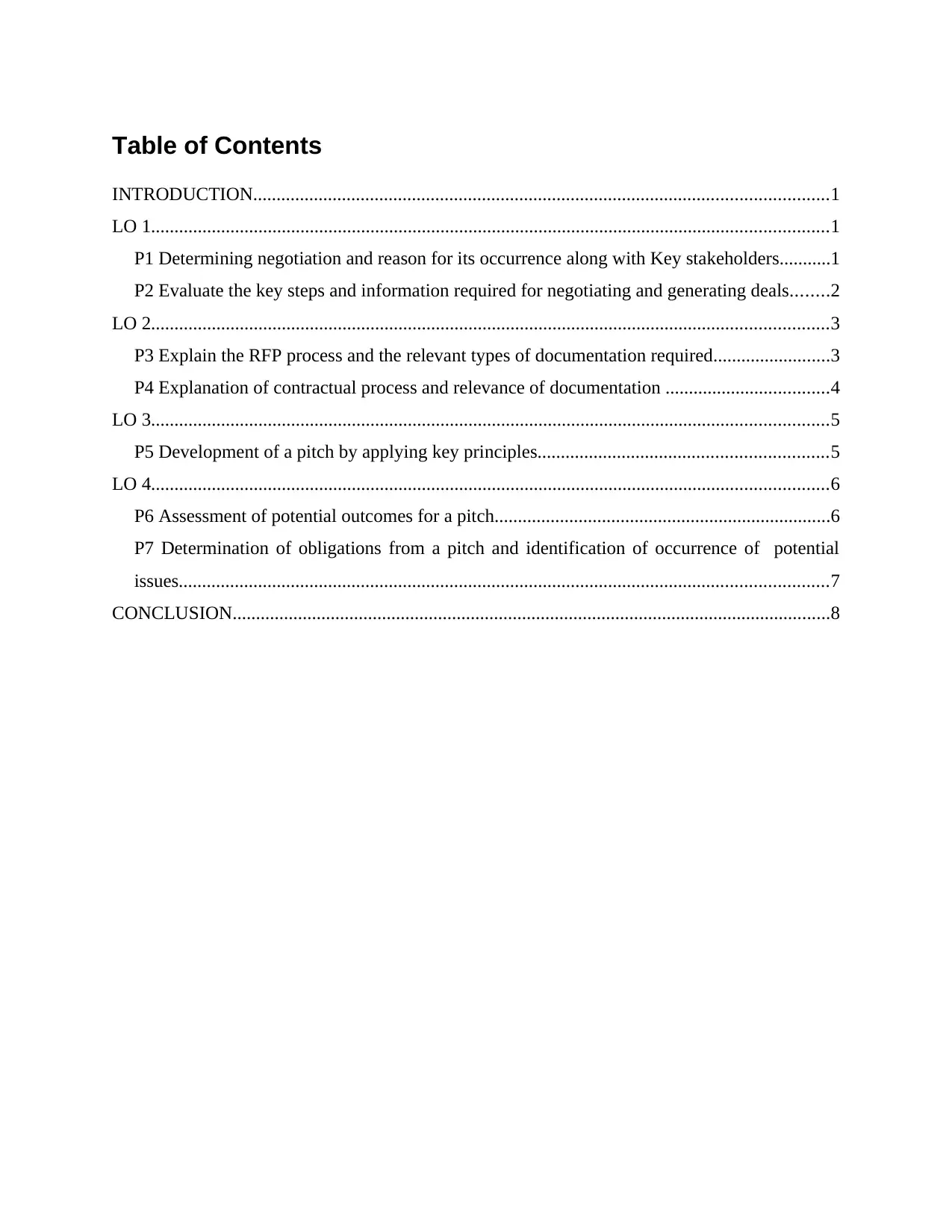
Table of Contents
INTRODUCTION...........................................................................................................................1
LO 1.................................................................................................................................................1
P1 Determining negotiation and reason for its occurrence along with Key stakeholders...........1
P2 Evaluate the key steps and information required for negotiating and generating deals........2
LO 2.................................................................................................................................................3
P3 Explain the RFP process and the relevant types of documentation required.........................3
P4 Explanation of contractual process and relevance of documentation ...................................4
LO 3.................................................................................................................................................5
P5 Development of a pitch by applying key principles..............................................................5
LO 4.................................................................................................................................................6
P6 Assessment of potential outcomes for a pitch........................................................................6
P7 Determination of obligations from a pitch and identification of occurrence of potential
issues...........................................................................................................................................7
CONCLUSION................................................................................................................................8
INTRODUCTION...........................................................................................................................1
LO 1.................................................................................................................................................1
P1 Determining negotiation and reason for its occurrence along with Key stakeholders...........1
P2 Evaluate the key steps and information required for negotiating and generating deals........2
LO 2.................................................................................................................................................3
P3 Explain the RFP process and the relevant types of documentation required.........................3
P4 Explanation of contractual process and relevance of documentation ...................................4
LO 3.................................................................................................................................................5
P5 Development of a pitch by applying key principles..............................................................5
LO 4.................................................................................................................................................6
P6 Assessment of potential outcomes for a pitch........................................................................6
P7 Determination of obligations from a pitch and identification of occurrence of potential
issues...........................................................................................................................................7
CONCLUSION................................................................................................................................8
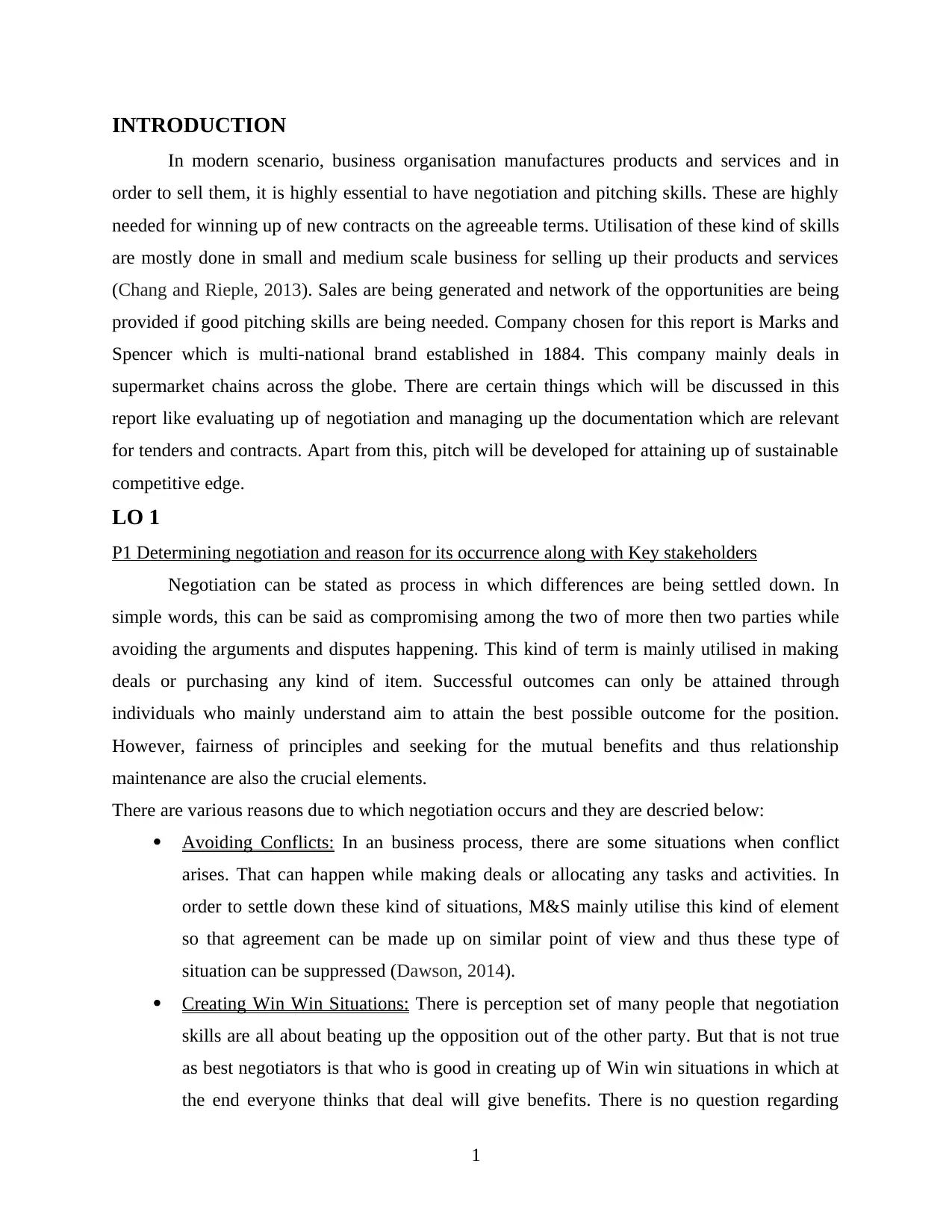
INTRODUCTION
In modern scenario, business organisation manufactures products and services and in
order to sell them, it is highly essential to have negotiation and pitching skills. These are highly
needed for winning up of new contracts on the agreeable terms. Utilisation of these kind of skills
are mostly done in small and medium scale business for selling up their products and services
(Chang and Rieple, 2013). Sales are being generated and network of the opportunities are being
provided if good pitching skills are being needed. Company chosen for this report is Marks and
Spencer which is multi-national brand established in 1884. This company mainly deals in
supermarket chains across the globe. There are certain things which will be discussed in this
report like evaluating up of negotiation and managing up the documentation which are relevant
for tenders and contracts. Apart from this, pitch will be developed for attaining up of sustainable
competitive edge.
LO 1
P1 Determining negotiation and reason for its occurrence along with Key stakeholders
Negotiation can be stated as process in which differences are being settled down. In
simple words, this can be said as compromising among the two of more then two parties while
avoiding the arguments and disputes happening. This kind of term is mainly utilised in making
deals or purchasing any kind of item. Successful outcomes can only be attained through
individuals who mainly understand aim to attain the best possible outcome for the position.
However, fairness of principles and seeking for the mutual benefits and thus relationship
maintenance are also the crucial elements.
There are various reasons due to which negotiation occurs and they are descried below:
Avoiding Conflicts: In an business process, there are some situations when conflict
arises. That can happen while making deals or allocating any tasks and activities. In
order to settle down these kind of situations, M&S mainly utilise this kind of element
so that agreement can be made up on similar point of view and thus these type of
situation can be suppressed (Dawson, 2014).
Creating Win Win Situations: There is perception set of many people that negotiation
skills are all about beating up the opposition out of the other party. But that is not true
as best negotiators is that who is good in creating up of Win win situations in which at
the end everyone thinks that deal will give benefits. There is no question regarding
1
In modern scenario, business organisation manufactures products and services and in
order to sell them, it is highly essential to have negotiation and pitching skills. These are highly
needed for winning up of new contracts on the agreeable terms. Utilisation of these kind of skills
are mostly done in small and medium scale business for selling up their products and services
(Chang and Rieple, 2013). Sales are being generated and network of the opportunities are being
provided if good pitching skills are being needed. Company chosen for this report is Marks and
Spencer which is multi-national brand established in 1884. This company mainly deals in
supermarket chains across the globe. There are certain things which will be discussed in this
report like evaluating up of negotiation and managing up the documentation which are relevant
for tenders and contracts. Apart from this, pitch will be developed for attaining up of sustainable
competitive edge.
LO 1
P1 Determining negotiation and reason for its occurrence along with Key stakeholders
Negotiation can be stated as process in which differences are being settled down. In
simple words, this can be said as compromising among the two of more then two parties while
avoiding the arguments and disputes happening. This kind of term is mainly utilised in making
deals or purchasing any kind of item. Successful outcomes can only be attained through
individuals who mainly understand aim to attain the best possible outcome for the position.
However, fairness of principles and seeking for the mutual benefits and thus relationship
maintenance are also the crucial elements.
There are various reasons due to which negotiation occurs and they are descried below:
Avoiding Conflicts: In an business process, there are some situations when conflict
arises. That can happen while making deals or allocating any tasks and activities. In
order to settle down these kind of situations, M&S mainly utilise this kind of element
so that agreement can be made up on similar point of view and thus these type of
situation can be suppressed (Dawson, 2014).
Creating Win Win Situations: There is perception set of many people that negotiation
skills are all about beating up the opposition out of the other party. But that is not true
as best negotiators is that who is good in creating up of Win win situations in which at
the end everyone thinks that deal will give benefits. There is no question regarding
1
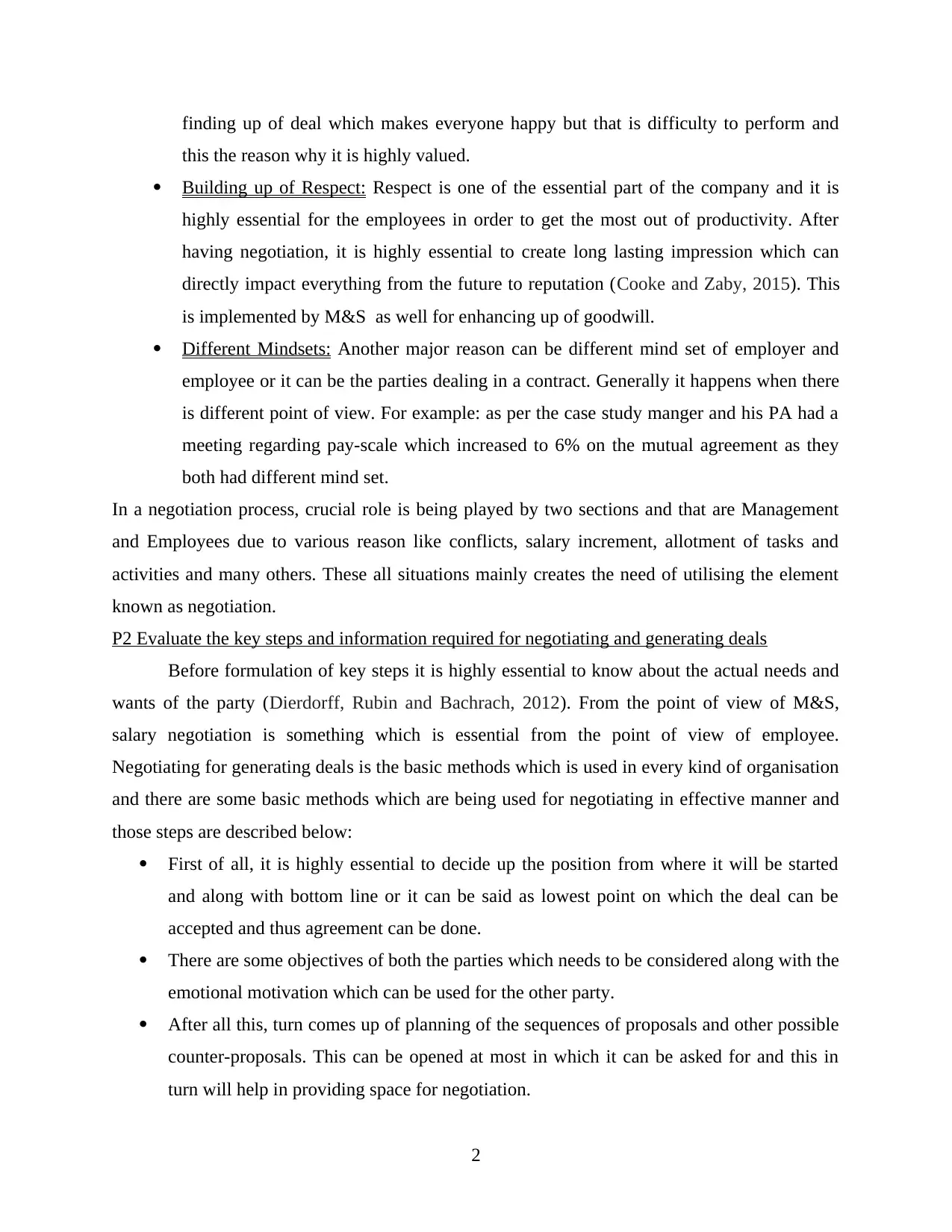
finding up of deal which makes everyone happy but that is difficulty to perform and
this the reason why it is highly valued.
Building up of Respect: Respect is one of the essential part of the company and it is
highly essential for the employees in order to get the most out of productivity. After
having negotiation, it is highly essential to create long lasting impression which can
directly impact everything from the future to reputation (Cooke and Zaby, 2015). This
is implemented by M&S as well for enhancing up of goodwill.
Different Mindsets: Another major reason can be different mind set of employer and
employee or it can be the parties dealing in a contract. Generally it happens when there
is different point of view. For example: as per the case study manger and his PA had a
meeting regarding pay-scale which increased to 6% on the mutual agreement as they
both had different mind set.
In a negotiation process, crucial role is being played by two sections and that are Management
and Employees due to various reason like conflicts, salary increment, allotment of tasks and
activities and many others. These all situations mainly creates the need of utilising the element
known as negotiation.
P2 Evaluate the key steps and information required for negotiating and generating deals
Before formulation of key steps it is highly essential to know about the actual needs and
wants of the party (Dierdorff, Rubin and Bachrach, 2012). From the point of view of M&S,
salary negotiation is something which is essential from the point of view of employee.
Negotiating for generating deals is the basic methods which is used in every kind of organisation
and there are some basic methods which are being used for negotiating in effective manner and
those steps are described below:
First of all, it is highly essential to decide up the position from where it will be started
and along with bottom line or it can be said as lowest point on which the deal can be
accepted and thus agreement can be done.
There are some objectives of both the parties which needs to be considered along with the
emotional motivation which can be used for the other party.
After all this, turn comes up of planning of the sequences of proposals and other possible
counter-proposals. This can be opened at most in which it can be asked for and this in
turn will help in providing space for negotiation.
2
this the reason why it is highly valued.
Building up of Respect: Respect is one of the essential part of the company and it is
highly essential for the employees in order to get the most out of productivity. After
having negotiation, it is highly essential to create long lasting impression which can
directly impact everything from the future to reputation (Cooke and Zaby, 2015). This
is implemented by M&S as well for enhancing up of goodwill.
Different Mindsets: Another major reason can be different mind set of employer and
employee or it can be the parties dealing in a contract. Generally it happens when there
is different point of view. For example: as per the case study manger and his PA had a
meeting regarding pay-scale which increased to 6% on the mutual agreement as they
both had different mind set.
In a negotiation process, crucial role is being played by two sections and that are Management
and Employees due to various reason like conflicts, salary increment, allotment of tasks and
activities and many others. These all situations mainly creates the need of utilising the element
known as negotiation.
P2 Evaluate the key steps and information required for negotiating and generating deals
Before formulation of key steps it is highly essential to know about the actual needs and
wants of the party (Dierdorff, Rubin and Bachrach, 2012). From the point of view of M&S,
salary negotiation is something which is essential from the point of view of employee.
Negotiating for generating deals is the basic methods which is used in every kind of organisation
and there are some basic methods which are being used for negotiating in effective manner and
those steps are described below:
First of all, it is highly essential to decide up the position from where it will be started
and along with bottom line or it can be said as lowest point on which the deal can be
accepted and thus agreement can be done.
There are some objectives of both the parties which needs to be considered along with the
emotional motivation which can be used for the other party.
After all this, turn comes up of planning of the sequences of proposals and other possible
counter-proposals. This can be opened at most in which it can be asked for and this in
turn will help in providing space for negotiation.
2
Secure Best Marks with AI Grader
Need help grading? Try our AI Grader for instant feedback on your assignments.
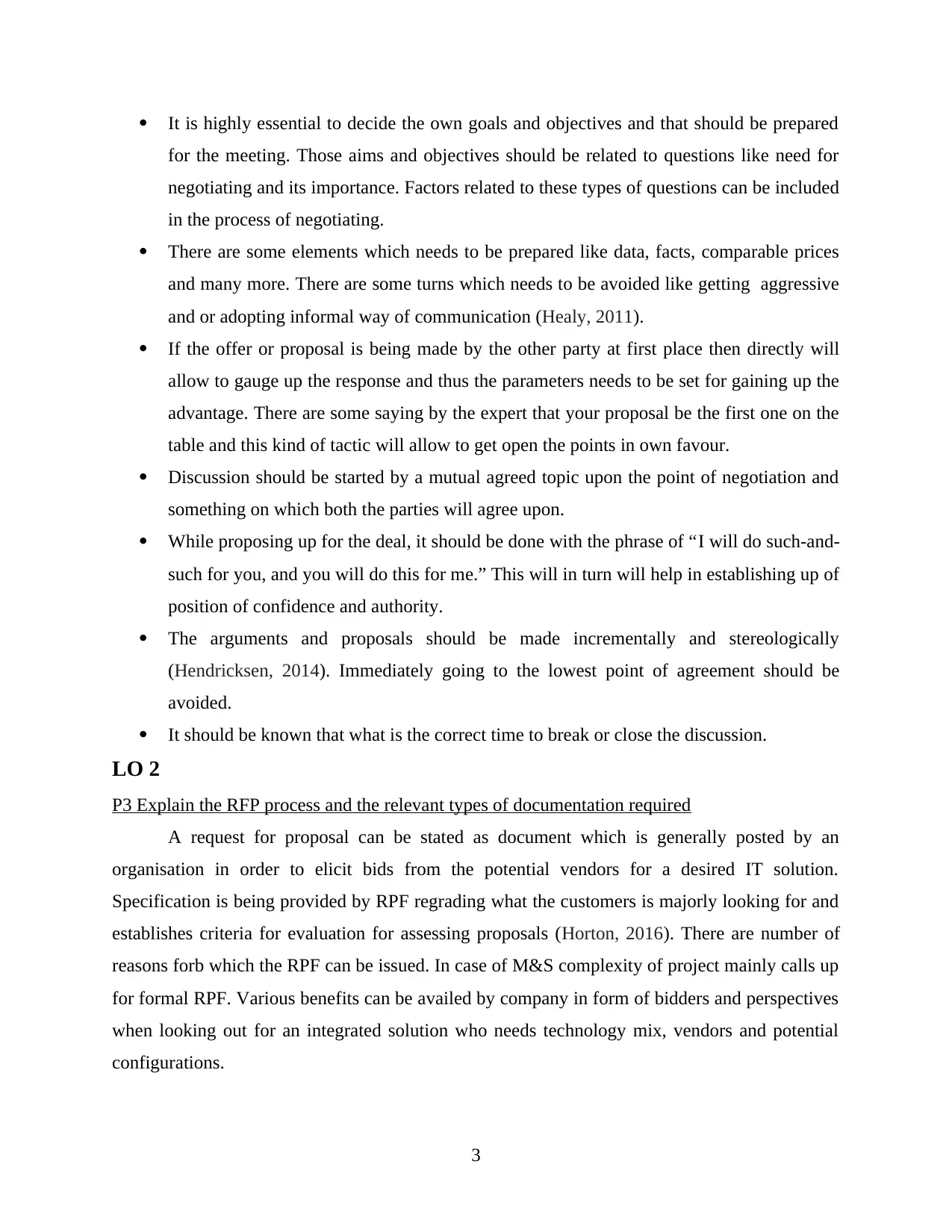
It is highly essential to decide the own goals and objectives and that should be prepared
for the meeting. Those aims and objectives should be related to questions like need for
negotiating and its importance. Factors related to these types of questions can be included
in the process of negotiating.
There are some elements which needs to be prepared like data, facts, comparable prices
and many more. There are some turns which needs to be avoided like getting aggressive
and or adopting informal way of communication (Healy, 2011).
If the offer or proposal is being made by the other party at first place then directly will
allow to gauge up the response and thus the parameters needs to be set for gaining up the
advantage. There are some saying by the expert that your proposal be the first one on the
table and this kind of tactic will allow to get open the points in own favour.
Discussion should be started by a mutual agreed topic upon the point of negotiation and
something on which both the parties will agree upon.
While proposing up for the deal, it should be done with the phrase of “I will do such-and-
such for you, and you will do this for me.” This will in turn will help in establishing up of
position of confidence and authority.
The arguments and proposals should be made incrementally and stereologically
(Hendricksen, 2014). Immediately going to the lowest point of agreement should be
avoided.
It should be known that what is the correct time to break or close the discussion.
LO 2
P3 Explain the RFP process and the relevant types of documentation required
A request for proposal can be stated as document which is generally posted by an
organisation in order to elicit bids from the potential vendors for a desired IT solution.
Specification is being provided by RPF regrading what the customers is majorly looking for and
establishes criteria for evaluation for assessing proposals (Horton, 2016). There are number of
reasons forb which the RPF can be issued. In case of M&S complexity of project mainly calls up
for formal RPF. Various benefits can be availed by company in form of bidders and perspectives
when looking out for an integrated solution who needs technology mix, vendors and potential
configurations.
3
for the meeting. Those aims and objectives should be related to questions like need for
negotiating and its importance. Factors related to these types of questions can be included
in the process of negotiating.
There are some elements which needs to be prepared like data, facts, comparable prices
and many more. There are some turns which needs to be avoided like getting aggressive
and or adopting informal way of communication (Healy, 2011).
If the offer or proposal is being made by the other party at first place then directly will
allow to gauge up the response and thus the parameters needs to be set for gaining up the
advantage. There are some saying by the expert that your proposal be the first one on the
table and this kind of tactic will allow to get open the points in own favour.
Discussion should be started by a mutual agreed topic upon the point of negotiation and
something on which both the parties will agree upon.
While proposing up for the deal, it should be done with the phrase of “I will do such-and-
such for you, and you will do this for me.” This will in turn will help in establishing up of
position of confidence and authority.
The arguments and proposals should be made incrementally and stereologically
(Hendricksen, 2014). Immediately going to the lowest point of agreement should be
avoided.
It should be known that what is the correct time to break or close the discussion.
LO 2
P3 Explain the RFP process and the relevant types of documentation required
A request for proposal can be stated as document which is generally posted by an
organisation in order to elicit bids from the potential vendors for a desired IT solution.
Specification is being provided by RPF regrading what the customers is majorly looking for and
establishes criteria for evaluation for assessing proposals (Horton, 2016). There are number of
reasons forb which the RPF can be issued. In case of M&S complexity of project mainly calls up
for formal RPF. Various benefits can be availed by company in form of bidders and perspectives
when looking out for an integrated solution who needs technology mix, vendors and potential
configurations.
3
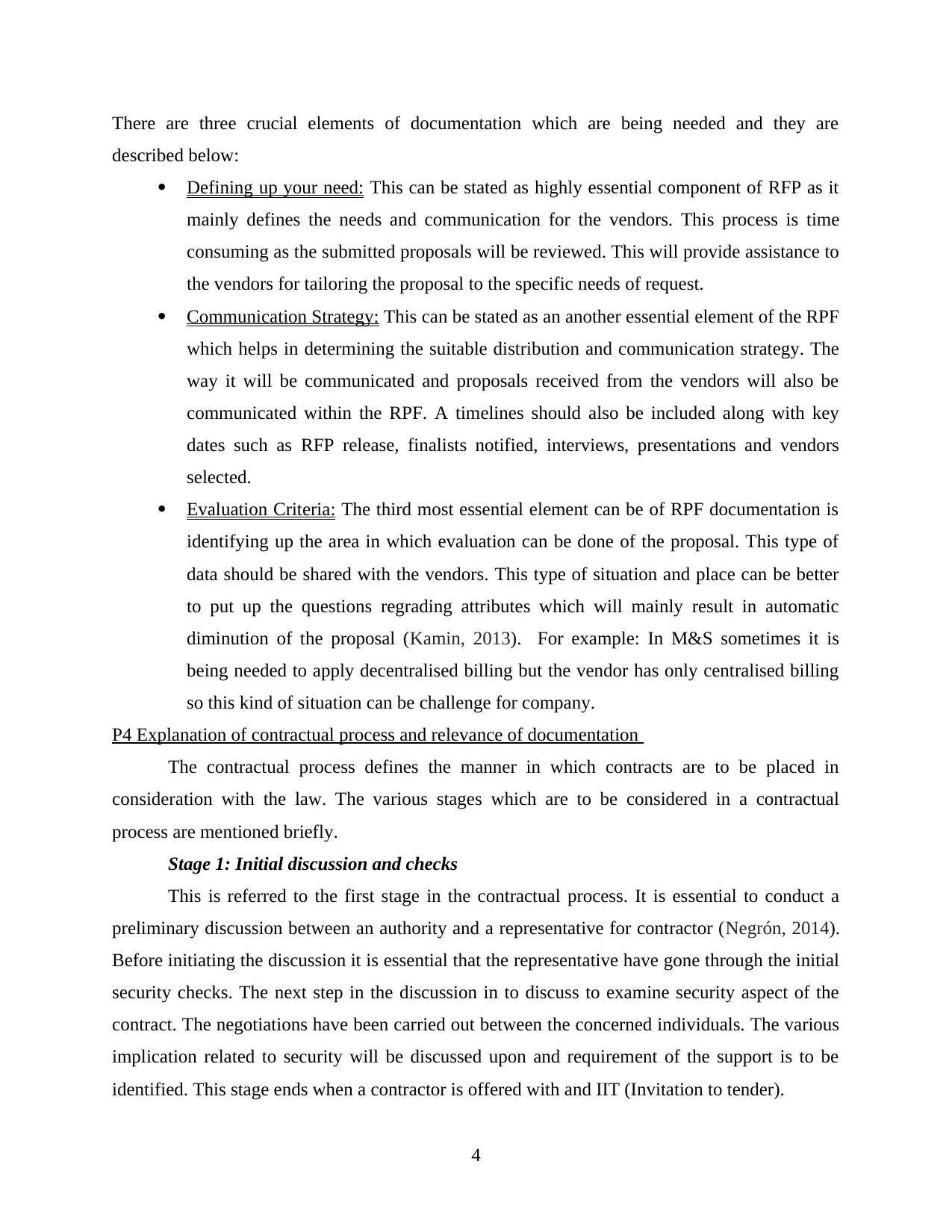
There are three crucial elements of documentation which are being needed and they are
described below:
Defining up your need: This can be stated as highly essential component of RFP as it
mainly defines the needs and communication for the vendors. This process is time
consuming as the submitted proposals will be reviewed. This will provide assistance to
the vendors for tailoring the proposal to the specific needs of request.
Communication Strategy: This can be stated as an another essential element of the RPF
which helps in determining the suitable distribution and communication strategy. The
way it will be communicated and proposals received from the vendors will also be
communicated within the RPF. A timelines should also be included along with key
dates such as RFP release, finalists notified, interviews, presentations and vendors
selected.
Evaluation Criteria: The third most essential element can be of RPF documentation is
identifying up the area in which evaluation can be done of the proposal. This type of
data should be shared with the vendors. This type of situation and place can be better
to put up the questions regrading attributes which will mainly result in automatic
diminution of the proposal (Kamin, 2013). For example: In M&S sometimes it is
being needed to apply decentralised billing but the vendor has only centralised billing
so this kind of situation can be challenge for company.
P4 Explanation of contractual process and relevance of documentation
The contractual process defines the manner in which contracts are to be placed in
consideration with the law. The various stages which are to be considered in a contractual
process are mentioned briefly.
Stage 1: Initial discussion and checks
This is referred to the first stage in the contractual process. It is essential to conduct a
preliminary discussion between an authority and a representative for contractor (Negrón, 2014).
Before initiating the discussion it is essential that the representative have gone through the initial
security checks. The next step in the discussion in to discuss to examine security aspect of the
contract. The negotiations have been carried out between the concerned individuals. The various
implication related to security will be discussed upon and requirement of the support is to be
identified. This stage ends when a contractor is offered with and IIT (Invitation to tender).
4
described below:
Defining up your need: This can be stated as highly essential component of RFP as it
mainly defines the needs and communication for the vendors. This process is time
consuming as the submitted proposals will be reviewed. This will provide assistance to
the vendors for tailoring the proposal to the specific needs of request.
Communication Strategy: This can be stated as an another essential element of the RPF
which helps in determining the suitable distribution and communication strategy. The
way it will be communicated and proposals received from the vendors will also be
communicated within the RPF. A timelines should also be included along with key
dates such as RFP release, finalists notified, interviews, presentations and vendors
selected.
Evaluation Criteria: The third most essential element can be of RPF documentation is
identifying up the area in which evaluation can be done of the proposal. This type of
data should be shared with the vendors. This type of situation and place can be better
to put up the questions regrading attributes which will mainly result in automatic
diminution of the proposal (Kamin, 2013). For example: In M&S sometimes it is
being needed to apply decentralised billing but the vendor has only centralised billing
so this kind of situation can be challenge for company.
P4 Explanation of contractual process and relevance of documentation
The contractual process defines the manner in which contracts are to be placed in
consideration with the law. The various stages which are to be considered in a contractual
process are mentioned briefly.
Stage 1: Initial discussion and checks
This is referred to the first stage in the contractual process. It is essential to conduct a
preliminary discussion between an authority and a representative for contractor (Negrón, 2014).
Before initiating the discussion it is essential that the representative have gone through the initial
security checks. The next step in the discussion in to discuss to examine security aspect of the
contract. The negotiations have been carried out between the concerned individuals. The various
implication related to security will be discussed upon and requirement of the support is to be
identified. This stage ends when a contractor is offered with and IIT (Invitation to tender).
4
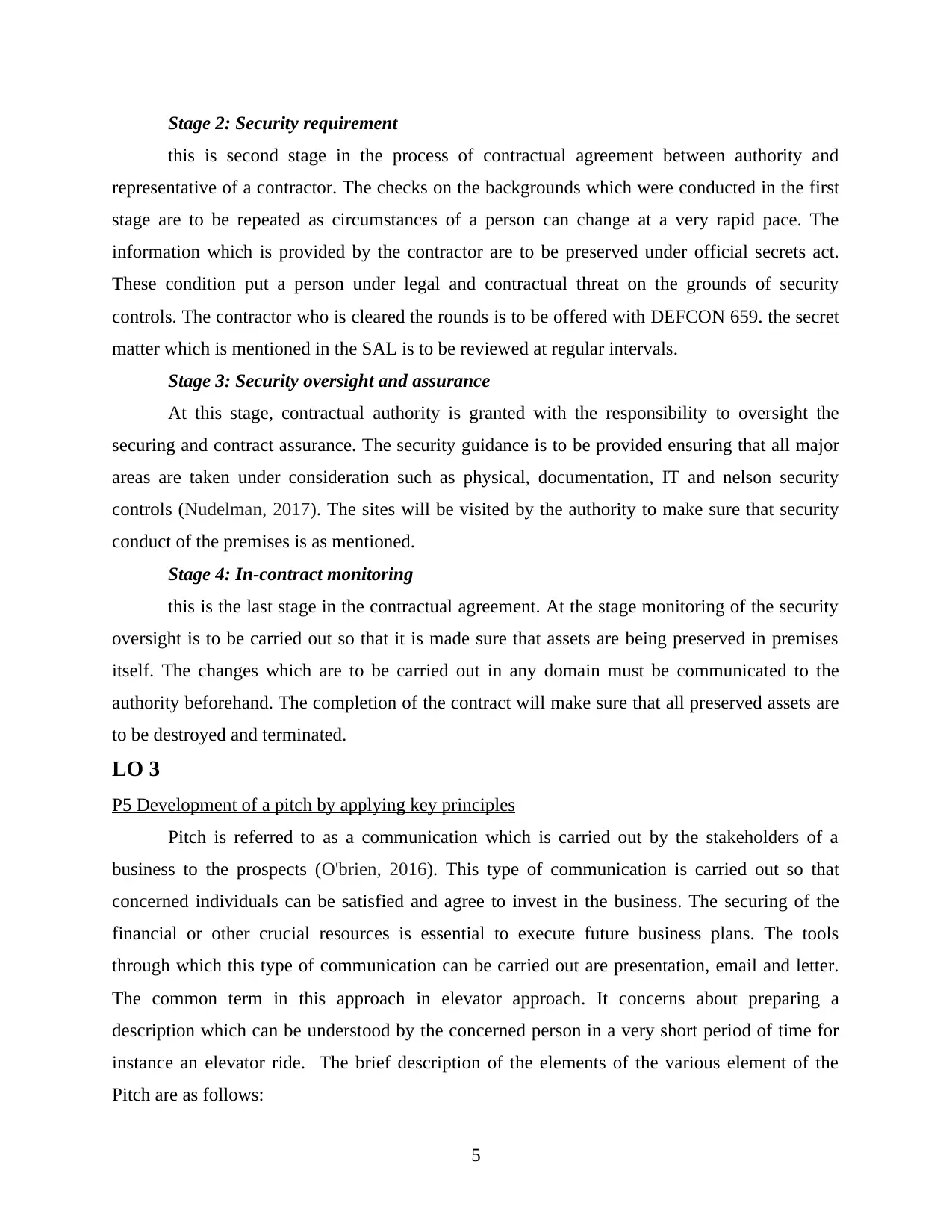
Stage 2: Security requirement
this is second stage in the process of contractual agreement between authority and
representative of a contractor. The checks on the backgrounds which were conducted in the first
stage are to be repeated as circumstances of a person can change at a very rapid pace. The
information which is provided by the contractor are to be preserved under official secrets act.
These condition put a person under legal and contractual threat on the grounds of security
controls. The contractor who is cleared the rounds is to be offered with DEFCON 659. the secret
matter which is mentioned in the SAL is to be reviewed at regular intervals.
Stage 3: Security oversight and assurance
At this stage, contractual authority is granted with the responsibility to oversight the
securing and contract assurance. The security guidance is to be provided ensuring that all major
areas are taken under consideration such as physical, documentation, IT and nelson security
controls (Nudelman, 2017). The sites will be visited by the authority to make sure that security
conduct of the premises is as mentioned.
Stage 4: In-contract monitoring
this is the last stage in the contractual agreement. At the stage monitoring of the security
oversight is to be carried out so that it is made sure that assets are being preserved in premises
itself. The changes which are to be carried out in any domain must be communicated to the
authority beforehand. The completion of the contract will make sure that all preserved assets are
to be destroyed and terminated.
LO 3
P5 Development of a pitch by applying key principles
Pitch is referred to as a communication which is carried out by the stakeholders of a
business to the prospects (O'brien, 2016). This type of communication is carried out so that
concerned individuals can be satisfied and agree to invest in the business. The securing of the
financial or other crucial resources is essential to execute future business plans. The tools
through which this type of communication can be carried out are presentation, email and letter.
The common term in this approach in elevator approach. It concerns about preparing a
description which can be understood by the concerned person in a very short period of time for
instance an elevator ride. The brief description of the elements of the various element of the
Pitch are as follows:
5
this is second stage in the process of contractual agreement between authority and
representative of a contractor. The checks on the backgrounds which were conducted in the first
stage are to be repeated as circumstances of a person can change at a very rapid pace. The
information which is provided by the contractor are to be preserved under official secrets act.
These condition put a person under legal and contractual threat on the grounds of security
controls. The contractor who is cleared the rounds is to be offered with DEFCON 659. the secret
matter which is mentioned in the SAL is to be reviewed at regular intervals.
Stage 3: Security oversight and assurance
At this stage, contractual authority is granted with the responsibility to oversight the
securing and contract assurance. The security guidance is to be provided ensuring that all major
areas are taken under consideration such as physical, documentation, IT and nelson security
controls (Nudelman, 2017). The sites will be visited by the authority to make sure that security
conduct of the premises is as mentioned.
Stage 4: In-contract monitoring
this is the last stage in the contractual agreement. At the stage monitoring of the security
oversight is to be carried out so that it is made sure that assets are being preserved in premises
itself. The changes which are to be carried out in any domain must be communicated to the
authority beforehand. The completion of the contract will make sure that all preserved assets are
to be destroyed and terminated.
LO 3
P5 Development of a pitch by applying key principles
Pitch is referred to as a communication which is carried out by the stakeholders of a
business to the prospects (O'brien, 2016). This type of communication is carried out so that
concerned individuals can be satisfied and agree to invest in the business. The securing of the
financial or other crucial resources is essential to execute future business plans. The tools
through which this type of communication can be carried out are presentation, email and letter.
The common term in this approach in elevator approach. It concerns about preparing a
description which can be understood by the concerned person in a very short period of time for
instance an elevator ride. The brief description of the elements of the various element of the
Pitch are as follows:
5
Paraphrase This Document
Need a fresh take? Get an instant paraphrase of this document with our AI Paraphraser
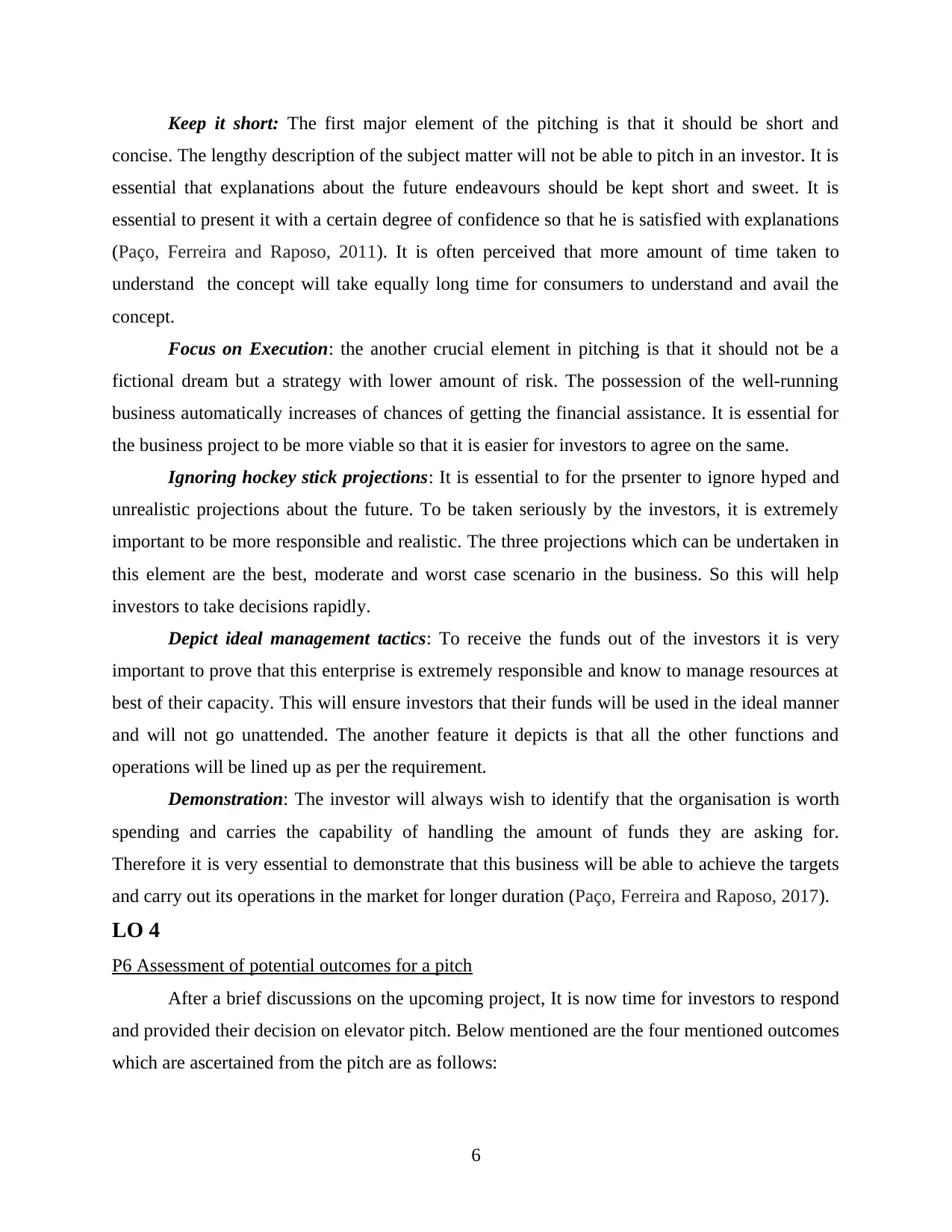
Keep it short: The first major element of the pitching is that it should be short and
concise. The lengthy description of the subject matter will not be able to pitch in an investor. It is
essential that explanations about the future endeavours should be kept short and sweet. It is
essential to present it with a certain degree of confidence so that he is satisfied with explanations
(Paço, Ferreira and Raposo, 2011). It is often perceived that more amount of time taken to
understand the concept will take equally long time for consumers to understand and avail the
concept.
Focus on Execution: the another crucial element in pitching is that it should not be a
fictional dream but a strategy with lower amount of risk. The possession of the well-running
business automatically increases of chances of getting the financial assistance. It is essential for
the business project to be more viable so that it is easier for investors to agree on the same.
Ignoring hockey stick projections: It is essential to for the prsenter to ignore hyped and
unrealistic projections about the future. To be taken seriously by the investors, it is extremely
important to be more responsible and realistic. The three projections which can be undertaken in
this element are the best, moderate and worst case scenario in the business. So this will help
investors to take decisions rapidly.
Depict ideal management tactics: To receive the funds out of the investors it is very
important to prove that this enterprise is extremely responsible and know to manage resources at
best of their capacity. This will ensure investors that their funds will be used in the ideal manner
and will not go unattended. The another feature it depicts is that all the other functions and
operations will be lined up as per the requirement.
Demonstration: The investor will always wish to identify that the organisation is worth
spending and carries the capability of handling the amount of funds they are asking for.
Therefore it is very essential to demonstrate that this business will be able to achieve the targets
and carry out its operations in the market for longer duration (Paço, Ferreira and Raposo, 2017).
LO 4
P6 Assessment of potential outcomes for a pitch
After a brief discussions on the upcoming project, It is now time for investors to respond
and provided their decision on elevator pitch. Below mentioned are the four mentioned outcomes
which are ascertained from the pitch are as follows:
6
concise. The lengthy description of the subject matter will not be able to pitch in an investor. It is
essential that explanations about the future endeavours should be kept short and sweet. It is
essential to present it with a certain degree of confidence so that he is satisfied with explanations
(Paço, Ferreira and Raposo, 2011). It is often perceived that more amount of time taken to
understand the concept will take equally long time for consumers to understand and avail the
concept.
Focus on Execution: the another crucial element in pitching is that it should not be a
fictional dream but a strategy with lower amount of risk. The possession of the well-running
business automatically increases of chances of getting the financial assistance. It is essential for
the business project to be more viable so that it is easier for investors to agree on the same.
Ignoring hockey stick projections: It is essential to for the prsenter to ignore hyped and
unrealistic projections about the future. To be taken seriously by the investors, it is extremely
important to be more responsible and realistic. The three projections which can be undertaken in
this element are the best, moderate and worst case scenario in the business. So this will help
investors to take decisions rapidly.
Depict ideal management tactics: To receive the funds out of the investors it is very
important to prove that this enterprise is extremely responsible and know to manage resources at
best of their capacity. This will ensure investors that their funds will be used in the ideal manner
and will not go unattended. The another feature it depicts is that all the other functions and
operations will be lined up as per the requirement.
Demonstration: The investor will always wish to identify that the organisation is worth
spending and carries the capability of handling the amount of funds they are asking for.
Therefore it is very essential to demonstrate that this business will be able to achieve the targets
and carry out its operations in the market for longer duration (Paço, Ferreira and Raposo, 2017).
LO 4
P6 Assessment of potential outcomes for a pitch
After a brief discussions on the upcoming project, It is now time for investors to respond
and provided their decision on elevator pitch. Below mentioned are the four mentioned outcomes
which are ascertained from the pitch are as follows:
6
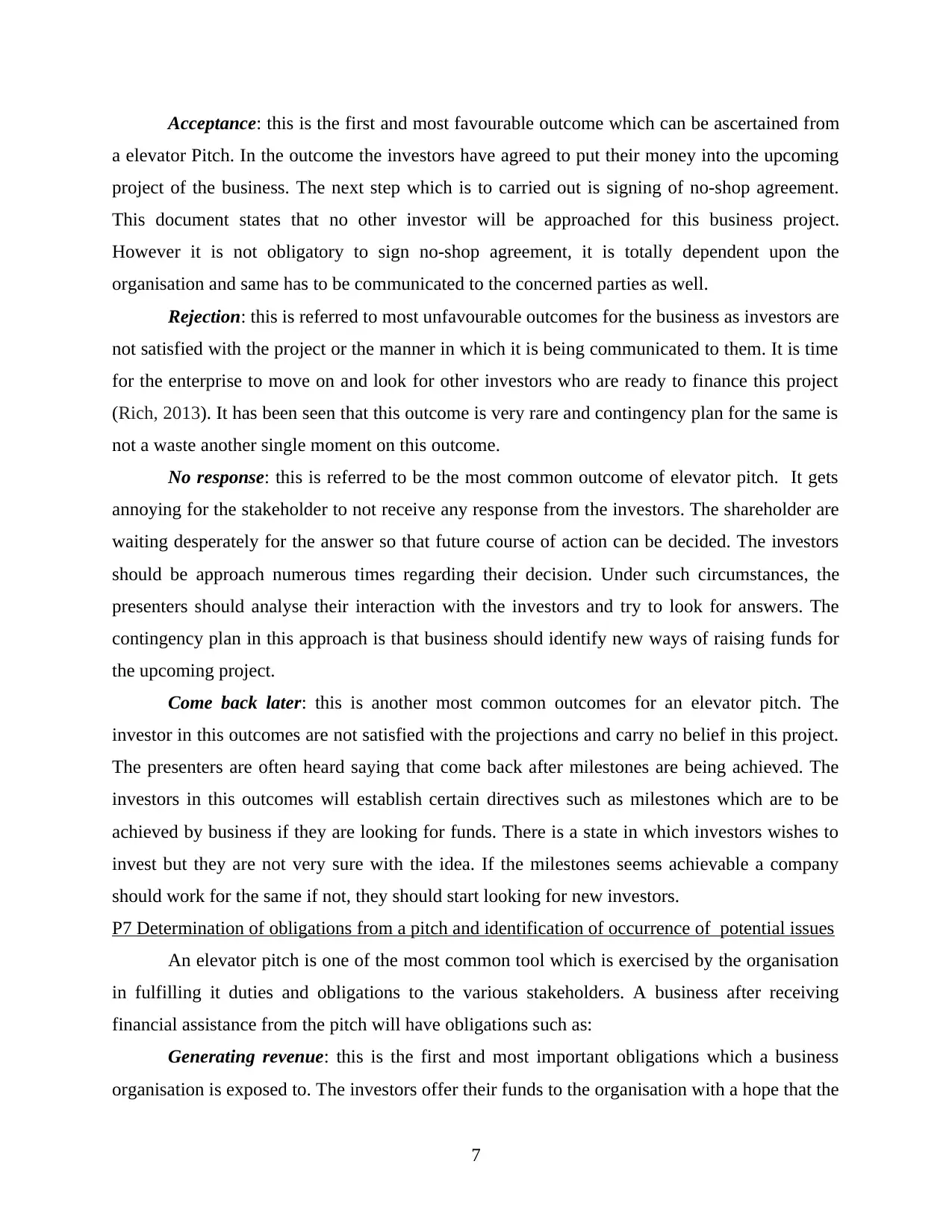
Acceptance: this is the first and most favourable outcome which can be ascertained from
a elevator Pitch. In the outcome the investors have agreed to put their money into the upcoming
project of the business. The next step which is to carried out is signing of no-shop agreement.
This document states that no other investor will be approached for this business project.
However it is not obligatory to sign no-shop agreement, it is totally dependent upon the
organisation and same has to be communicated to the concerned parties as well.
Rejection: this is referred to most unfavourable outcomes for the business as investors are
not satisfied with the project or the manner in which it is being communicated to them. It is time
for the enterprise to move on and look for other investors who are ready to finance this project
(Rich, 2013). It has been seen that this outcome is very rare and contingency plan for the same is
not a waste another single moment on this outcome.
No response: this is referred to be the most common outcome of elevator pitch. It gets
annoying for the stakeholder to not receive any response from the investors. The shareholder are
waiting desperately for the answer so that future course of action can be decided. The investors
should be approach numerous times regarding their decision. Under such circumstances, the
presenters should analyse their interaction with the investors and try to look for answers. The
contingency plan in this approach is that business should identify new ways of raising funds for
the upcoming project.
Come back later: this is another most common outcomes for an elevator pitch. The
investor in this outcomes are not satisfied with the projections and carry no belief in this project.
The presenters are often heard saying that come back after milestones are being achieved. The
investors in this outcomes will establish certain directives such as milestones which are to be
achieved by business if they are looking for funds. There is a state in which investors wishes to
invest but they are not very sure with the idea. If the milestones seems achievable a company
should work for the same if not, they should start looking for new investors.
P7 Determination of obligations from a pitch and identification of occurrence of potential issues
An elevator pitch is one of the most common tool which is exercised by the organisation
in fulfilling it duties and obligations to the various stakeholders. A business after receiving
financial assistance from the pitch will have obligations such as:
Generating revenue: this is the first and most important obligations which a business
organisation is exposed to. The investors offer their funds to the organisation with a hope that the
7
a elevator Pitch. In the outcome the investors have agreed to put their money into the upcoming
project of the business. The next step which is to carried out is signing of no-shop agreement.
This document states that no other investor will be approached for this business project.
However it is not obligatory to sign no-shop agreement, it is totally dependent upon the
organisation and same has to be communicated to the concerned parties as well.
Rejection: this is referred to most unfavourable outcomes for the business as investors are
not satisfied with the project or the manner in which it is being communicated to them. It is time
for the enterprise to move on and look for other investors who are ready to finance this project
(Rich, 2013). It has been seen that this outcome is very rare and contingency plan for the same is
not a waste another single moment on this outcome.
No response: this is referred to be the most common outcome of elevator pitch. It gets
annoying for the stakeholder to not receive any response from the investors. The shareholder are
waiting desperately for the answer so that future course of action can be decided. The investors
should be approach numerous times regarding their decision. Under such circumstances, the
presenters should analyse their interaction with the investors and try to look for answers. The
contingency plan in this approach is that business should identify new ways of raising funds for
the upcoming project.
Come back later: this is another most common outcomes for an elevator pitch. The
investor in this outcomes are not satisfied with the projections and carry no belief in this project.
The presenters are often heard saying that come back after milestones are being achieved. The
investors in this outcomes will establish certain directives such as milestones which are to be
achieved by business if they are looking for funds. There is a state in which investors wishes to
invest but they are not very sure with the idea. If the milestones seems achievable a company
should work for the same if not, they should start looking for new investors.
P7 Determination of obligations from a pitch and identification of occurrence of potential issues
An elevator pitch is one of the most common tool which is exercised by the organisation
in fulfilling it duties and obligations to the various stakeholders. A business after receiving
financial assistance from the pitch will have obligations such as:
Generating revenue: this is the first and most important obligations which a business
organisation is exposed to. The investors offer their funds to the organisation with a hope that the
7
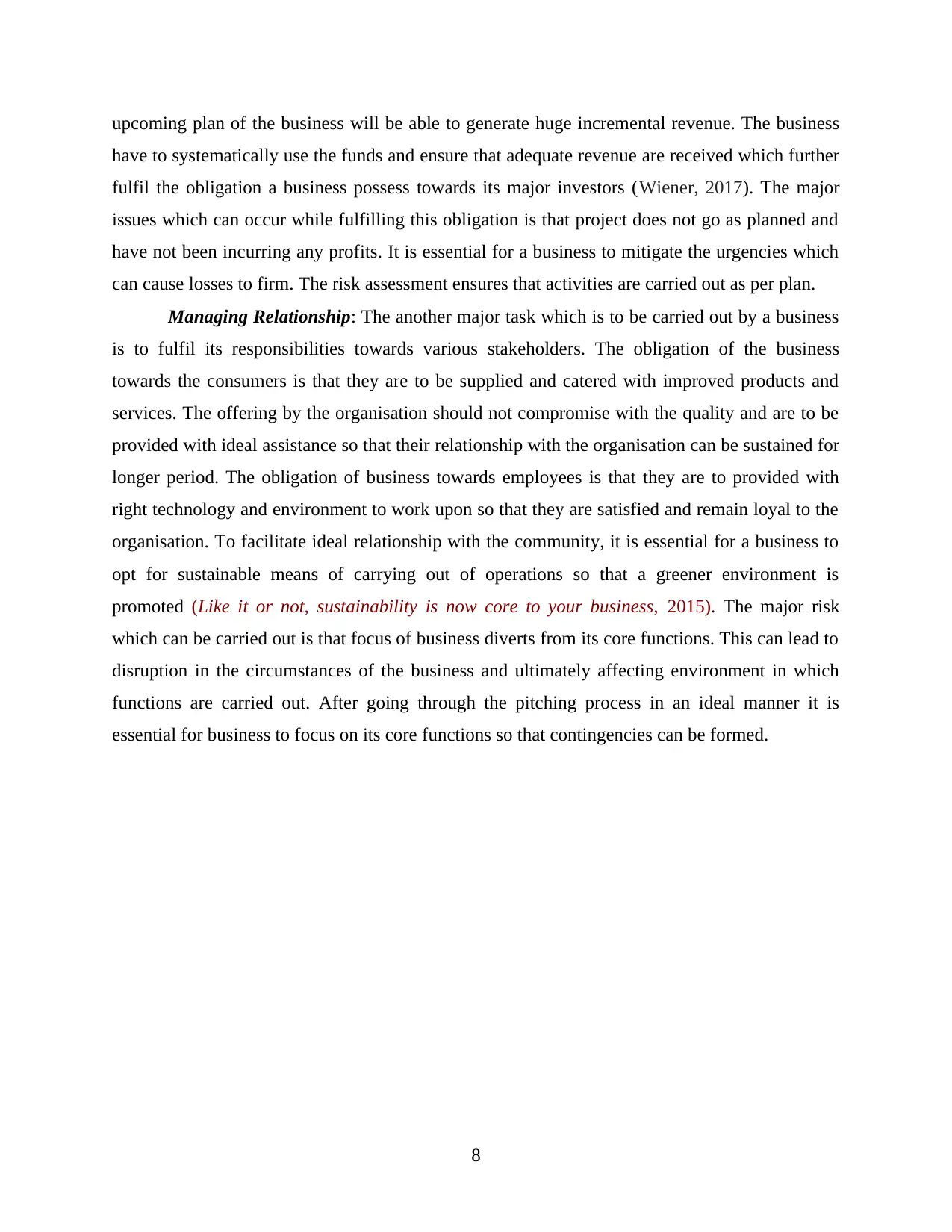
upcoming plan of the business will be able to generate huge incremental revenue. The business
have to systematically use the funds and ensure that adequate revenue are received which further
fulfil the obligation a business possess towards its major investors (Wiener, 2017). The major
issues which can occur while fulfilling this obligation is that project does not go as planned and
have not been incurring any profits. It is essential for a business to mitigate the urgencies which
can cause losses to firm. The risk assessment ensures that activities are carried out as per plan.
Managing Relationship: The another major task which is to be carried out by a business
is to fulfil its responsibilities towards various stakeholders. The obligation of the business
towards the consumers is that they are to be supplied and catered with improved products and
services. The offering by the organisation should not compromise with the quality and are to be
provided with ideal assistance so that their relationship with the organisation can be sustained for
longer period. The obligation of business towards employees is that they are to provided with
right technology and environment to work upon so that they are satisfied and remain loyal to the
organisation. To facilitate ideal relationship with the community, it is essential for a business to
opt for sustainable means of carrying out of operations so that a greener environment is
promoted (Like it or not, sustainability is now core to your business, 2015). The major risk
which can be carried out is that focus of business diverts from its core functions. This can lead to
disruption in the circumstances of the business and ultimately affecting environment in which
functions are carried out. After going through the pitching process in an ideal manner it is
essential for business to focus on its core functions so that contingencies can be formed.
8
have to systematically use the funds and ensure that adequate revenue are received which further
fulfil the obligation a business possess towards its major investors (Wiener, 2017). The major
issues which can occur while fulfilling this obligation is that project does not go as planned and
have not been incurring any profits. It is essential for a business to mitigate the urgencies which
can cause losses to firm. The risk assessment ensures that activities are carried out as per plan.
Managing Relationship: The another major task which is to be carried out by a business
is to fulfil its responsibilities towards various stakeholders. The obligation of the business
towards the consumers is that they are to be supplied and catered with improved products and
services. The offering by the organisation should not compromise with the quality and are to be
provided with ideal assistance so that their relationship with the organisation can be sustained for
longer period. The obligation of business towards employees is that they are to provided with
right technology and environment to work upon so that they are satisfied and remain loyal to the
organisation. To facilitate ideal relationship with the community, it is essential for a business to
opt for sustainable means of carrying out of operations so that a greener environment is
promoted (Like it or not, sustainability is now core to your business, 2015). The major risk
which can be carried out is that focus of business diverts from its core functions. This can lead to
disruption in the circumstances of the business and ultimately affecting environment in which
functions are carried out. After going through the pitching process in an ideal manner it is
essential for business to focus on its core functions so that contingencies can be formed.
8
Secure Best Marks with AI Grader
Need help grading? Try our AI Grader for instant feedback on your assignments.

CONCLUSION
From the above report, it can be concluded that negotiation and pitching up is highly
essential for the company which is specially small and middle level of organisation. Negotiation
is mainly done with the motive of settling up of conflicts and creating win win situations for both
of the parties. Apart from this there are various steps which are being utilised for making
effective process of negotiation and thus to get better outcomes. There are various things which
will be discussed like outcomes of pitching and negotiation and managing up of documentation
which are being related to tenders and contracts so that aims and objectives of firm can be
attained in positive and effective manner.
9
From the above report, it can be concluded that negotiation and pitching up is highly
essential for the company which is specially small and middle level of organisation. Negotiation
is mainly done with the motive of settling up of conflicts and creating win win situations for both
of the parties. Apart from this there are various steps which are being utilised for making
effective process of negotiation and thus to get better outcomes. There are various things which
will be discussed like outcomes of pitching and negotiation and managing up of documentation
which are being related to tenders and contracts so that aims and objectives of firm can be
attained in positive and effective manner.
9
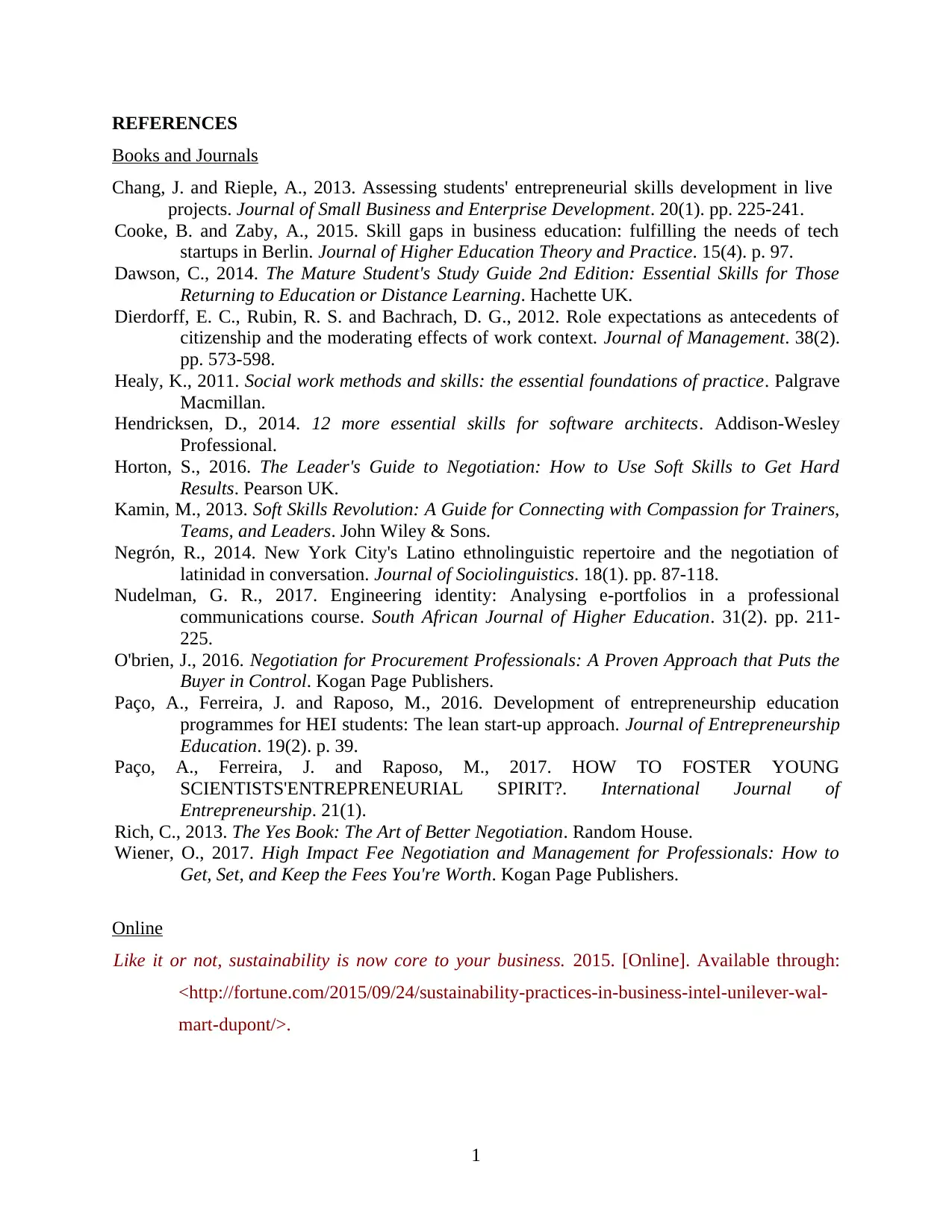
REFERENCES
Books and Journals
Chang, J. and Rieple, A., 2013. Assessing students' entrepreneurial skills development in live
projects. Journal of Small Business and Enterprise Development. 20(1). pp. 225-241.
Cooke, B. and Zaby, A., 2015. Skill gaps in business education: fulfilling the needs of tech
startups in Berlin. Journal of Higher Education Theory and Practice. 15(4). p. 97.
Dawson, C., 2014. The Mature Student's Study Guide 2nd Edition: Essential Skills for Those
Returning to Education or Distance Learning. Hachette UK.
Dierdorff, E. C., Rubin, R. S. and Bachrach, D. G., 2012. Role expectations as antecedents of
citizenship and the moderating effects of work context. Journal of Management. 38(2).
pp. 573-598.
Healy, K., 2011. Social work methods and skills: the essential foundations of practice. Palgrave
Macmillan.
Hendricksen, D., 2014. 12 more essential skills for software architects. Addison-Wesley
Professional.
Horton, S., 2016. The Leader's Guide to Negotiation: How to Use Soft Skills to Get Hard
Results. Pearson UK.
Kamin, M., 2013. Soft Skills Revolution: A Guide for Connecting with Compassion for Trainers,
Teams, and Leaders. John Wiley & Sons.
Negrón, R., 2014. New York City's Latino ethnolinguistic repertoire and the negotiation of
latinidad in conversation. Journal of Sociolinguistics. 18(1). pp. 87-118.
Nudelman, G. R., 2017. Engineering identity: Analysing e-portfolios in a professional
communications course. South African Journal of Higher Education. 31(2). pp. 211-
225.
O'brien, J., 2016. Negotiation for Procurement Professionals: A Proven Approach that Puts the
Buyer in Control. Kogan Page Publishers.
Paço, A., Ferreira, J. and Raposo, M., 2016. Development of entrepreneurship education
programmes for HEI students: The lean start-up approach. Journal of Entrepreneurship
Education. 19(2). p. 39.
Paço, A., Ferreira, J. and Raposo, M., 2017. HOW TO FOSTER YOUNG
SCIENTISTS'ENTREPRENEURIAL SPIRIT?. International Journal of
Entrepreneurship. 21(1).
Rich, C., 2013. The Yes Book: The Art of Better Negotiation. Random House.
Wiener, O., 2017. High Impact Fee Negotiation and Management for Professionals: How to
Get, Set, and Keep the Fees You're Worth. Kogan Page Publishers.
Online
Like it or not, sustainability is now core to your business. 2015. [Online]. Available through:
<http://fortune.com/2015/09/24/sustainability-practices-in-business-intel-unilever-wal-
mart-dupont/>.
1
Books and Journals
Chang, J. and Rieple, A., 2013. Assessing students' entrepreneurial skills development in live
projects. Journal of Small Business and Enterprise Development. 20(1). pp. 225-241.
Cooke, B. and Zaby, A., 2015. Skill gaps in business education: fulfilling the needs of tech
startups in Berlin. Journal of Higher Education Theory and Practice. 15(4). p. 97.
Dawson, C., 2014. The Mature Student's Study Guide 2nd Edition: Essential Skills for Those
Returning to Education or Distance Learning. Hachette UK.
Dierdorff, E. C., Rubin, R. S. and Bachrach, D. G., 2012. Role expectations as antecedents of
citizenship and the moderating effects of work context. Journal of Management. 38(2).
pp. 573-598.
Healy, K., 2011. Social work methods and skills: the essential foundations of practice. Palgrave
Macmillan.
Hendricksen, D., 2014. 12 more essential skills for software architects. Addison-Wesley
Professional.
Horton, S., 2016. The Leader's Guide to Negotiation: How to Use Soft Skills to Get Hard
Results. Pearson UK.
Kamin, M., 2013. Soft Skills Revolution: A Guide for Connecting with Compassion for Trainers,
Teams, and Leaders. John Wiley & Sons.
Negrón, R., 2014. New York City's Latino ethnolinguistic repertoire and the negotiation of
latinidad in conversation. Journal of Sociolinguistics. 18(1). pp. 87-118.
Nudelman, G. R., 2017. Engineering identity: Analysing e-portfolios in a professional
communications course. South African Journal of Higher Education. 31(2). pp. 211-
225.
O'brien, J., 2016. Negotiation for Procurement Professionals: A Proven Approach that Puts the
Buyer in Control. Kogan Page Publishers.
Paço, A., Ferreira, J. and Raposo, M., 2016. Development of entrepreneurship education
programmes for HEI students: The lean start-up approach. Journal of Entrepreneurship
Education. 19(2). p. 39.
Paço, A., Ferreira, J. and Raposo, M., 2017. HOW TO FOSTER YOUNG
SCIENTISTS'ENTREPRENEURIAL SPIRIT?. International Journal of
Entrepreneurship. 21(1).
Rich, C., 2013. The Yes Book: The Art of Better Negotiation. Random House.
Wiener, O., 2017. High Impact Fee Negotiation and Management for Professionals: How to
Get, Set, and Keep the Fees You're Worth. Kogan Page Publishers.
Online
Like it or not, sustainability is now core to your business. 2015. [Online]. Available through:
<http://fortune.com/2015/09/24/sustainability-practices-in-business-intel-unilever-wal-
mart-dupont/>.
1
1 out of 12
Related Documents
Your All-in-One AI-Powered Toolkit for Academic Success.
+13062052269
info@desklib.com
Available 24*7 on WhatsApp / Email
![[object Object]](/_next/static/media/star-bottom.7253800d.svg)
Unlock your academic potential
© 2024 | Zucol Services PVT LTD | All rights reserved.





